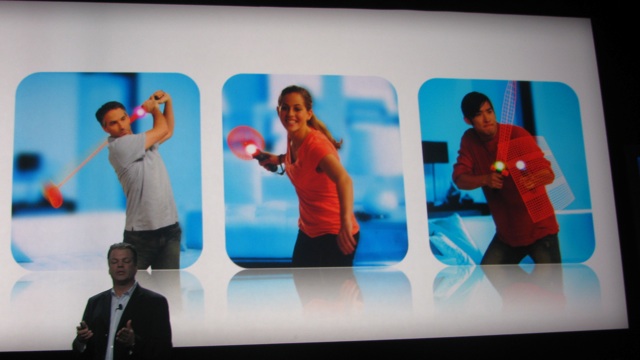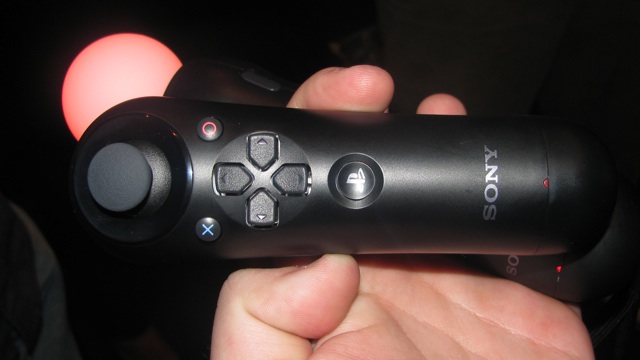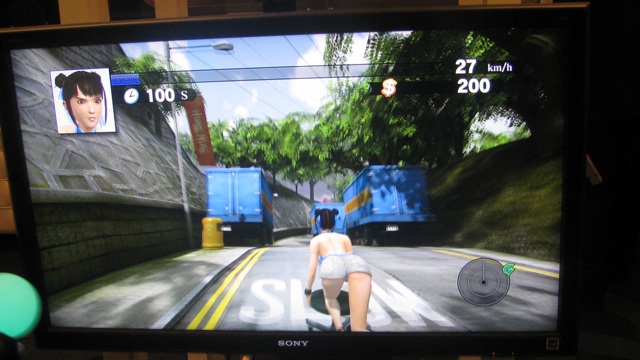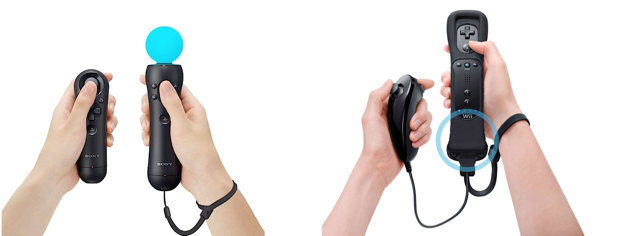
During a press event at the Game Developers Conference, Sony finally showed its motion controller to the gaming press. Welcome to the world of the PlayStation Move.
We were shown a number of videos and demos, and they all looked uncomfortably similar to what we've already played on the Nintendo Wii. Even the models, with a focus on females and families, made it look like we were in the realm of Nintendo. The reveal of the secondary controller with an analog stick—a product that again looked like a direct rip-off of a Nintendo product—drew either ambivalence or titters from the crowd. At a cocktail mixer directly after, we were able to get our hands on the Move directly, and play through the offerings.
How did people react? There is a distinct lack of enthusiasm for the product, and people were talking about similarities to Nintendo titles and about the price of the product in hushed tones. There were jokes made about the look of the Move; many people compared it to a certain sexual toy. Others placed the glowing orbs on their crotch, to mimic testicles. In short, there wasn't a lot of love for the Move at the launch.
But we've played the games, handled the hardware, and given the whole thing a long think, and we believe that the Move may not flop, although it could have had a stronger first showing. Here are the things we like about the hardware, and where Sony may have gone wrong.
There's a lot of hardware, and it will be expensive
Sony claimed that you'll be able to buy an entry-level Move setup for under $100, and there will also be a hardware bundle that comes with everything you'll need to get started. The problem is that the entry level may not include everything you need to play every game.

Sony showed multiple demos that required two PlayStation Move controllers, and others that required a secondary controller as well as a PlayStation Move. And you'll need the PlayStation Eye to play anything with the Move controller. So to be able to play all the games shown at GDC, you'll need two Move controllers, a PlayStation Eye, and a secondary controller. Somehow, we doubt those four pieces of hardware will be included in the entry-level bundle.
Combine all that hardware with multiple players and you're going to have a mess of controllers. Yes, the Wii suffers from this problem as well, but the Wii is already in people's homes, and it's available for a much lower price. If you're interested in motion control, you probably already have one. This is the same problem rhythm games are suffering from—how many of these wands and secondary controllers and nunchuks and sensor bars and cameras are people going to tolerate? How much are people going to pay for scads of extra hardware on top of their $300 PlayStation 3 systems?
To sum up, Microsoft's Project Natal will be a single camera; the Nintendo Wii comes with its motion controller; but Sony is pushing three distinct peripherals, and a complete set will be four pieces of hardware. That's non-optimal, to say the least.
Ergonomics
The Move controllers are definitely comfortable, and they're good for left or right-handed gamers. The buttons and triggers all feel good. The problem is that the Move controller has a single "action" button that dominates the top of the hardware, and it's surrounded by buttons in a square pattern. It can be tricky to figure out what buttons to hit by responding to prompts on the screen. We were asked if it would be easier if the buttons were arranged in a diamond shape by a Sony producer, and that seemed to make more sense. It's very possible this isn't the final hardware, and Sony is weighing its options.
The ball at the top is actually slightly squishy, and the colors can change as you play, which can be slightly distracting. Still, for as many pieces of hardware as you'll need, at least they feel solid.
The software just isn't there yet
We played a number of Move games, including The Shoot, which is a rudimentary light gun game with a few motions used to activate special powers; Move Party, which looked and felt like a collection of Eye Toy games from the PlayStation 2 era; the gladiator demo, where we smacked around a fighter with a hammer and blocked her attacks with a shield; and Slider, where we controlled a busty secretary avoiding organized crime by riding an office chair.
It's bad news when you reveal a product this large, with so much riding on it, and within an hour people are putting down the controller and walking away from the demos. If a good announcement takes place, people want to rip the game out of the demos and take it home with them. With the Move, everyone agreed they were having fun, but no one seemed ready to get out their wallets.

It felt much more like a series of tech demos than a look at the future of PlayStation 3 gaming. There is plenty of time for great games to come out using the Move, but during our first look at the hardware, it was hard to pick out a killer app, or a game that would excite the masses.
It's a me-too product
Sony's Peter Dille stressed the fact that families that had grown out of the Nintendo Wii would find a home with the PlayStation Move, but does that demographic exist? The Nintendo Wii doesn't show any sign of slowing its sales momentum, and those that already have the system are probably not looking for a more expensive choice in motion controls with higher definition.

For all of Sony's rhetoric about customers outgrowing the Wii, the launch contained plenty of apparent nods in Nintendo's direction. We saw things that looked like Wii Sports: a bowling game and an archery game and table tennis. In the promo materials we saw families happily playing with the Wiimotes-slash-PlayStation Move and nunchuks-slash-secondary controllers attached. The marketing is just too similar, and even though Sony has been toying with this technology for around a decade, the fact that it's now being brought to the market in this configuration shows just how closely Sony is keeping an eye on Nintendo's success.
It's never good when you stop taking a leadership position and begin following the leader, and in this case it's clear that's what Sony has done. Nintendo of America's Reggie Fils-Aime commented on the PlayStation Move and summed up his position. "I think we would have been embarrassed to do what our competitors are currently doing," he told Kotaku. "So, all I can tell you is that we will innovate. We will provide something new. Something that the consumer and the industry will look at and say, 'Wow, I didn't see that coming.'"
reader comments
102